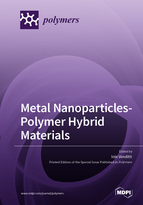Metal Nanoparticles-Polymer Hybrid Materials
A special issue of Polymers (ISSN 2073-4360). This special issue belongs to the section "Polymer Processing and Engineering".
Deadline for manuscript submissions: closed (31 December 2020) | Viewed by 31729
Special Issue Editor
Interests: nanomaterials; inorganic chemistry; drug delivery; sensing; optical materials; photonics
Special Issues, Collections and Topics in MDPI journals
Special Issue Information
Dear Colleagues,
We would like to invite you to submit your papers about hybrid materials, based on metal nanoparticles and polymers, to this Special Issue of Polymers.
Metal nanoparticles/polymers hybrid materials have significantly contributed to the develop of nanotechnology. Moreover, these hybrid materials can respond to stimuli (e.g., pH, temperature, light, magnetic field) or self-degrade in a controlled manner to release metal nanoparticles or therapeutics encapsulated. Functional and structural hybrid materials provide opportunities for creative fields, remarkable properties, and future advanced applications.
This Special Issue focuses on highlighting the progress of new hybrid materials, based on metal nanoparticles and polymers, their design, preparation, functionalization, characterization, and advanced applications.
We invite you to submit a manuscript for this Special Issue. Full papers, communications, and reviews are all welcome.
The focuses of this Special Issue are (but not limited) as follows:
- Design of new metal nanoparticles/polymers hybrid materials
- Development and preparation methods of metal nanoparticles/polymers hybrid materials
- Properties of nanoparticles–reinforced polymers (mechanical, thermal, electrical, optical, chemical, magnetic, etc.)
- Structure–property relationships in metal nanoparticles/polymers hybrid materials
- Metal nanoparticles/polymers hybrid materials in plasmonics and photonics applications
- Functional metal nanoparticles/polymers hybrid materials for energy conversion and storage
- Low dimensional metal nanoparticles/polymers hybrid materials in biotechnology
- Multi-functional smart metal nanoparticles/polymers hybrid materials.
Prof. Iole Venditti
Guest Editor
Manuscript Submission Information
Manuscripts should be submitted online at www.mdpi.com by registering and logging in to this website. Once you are registered, click here to go to the submission form. Manuscripts can be submitted until the deadline. All submissions that pass pre-check are peer-reviewed. Accepted papers will be published continuously in the journal (as soon as accepted) and will be listed together on the special issue website. Research articles, review articles as well as short communications are invited. For planned papers, a title and short abstract (about 100 words) can be sent to the Editorial Office for announcement on this website.
Submitted manuscripts should not have been published previously, nor be under consideration for publication elsewhere (except conference proceedings papers). All manuscripts are thoroughly refereed through a single-blind peer-review process. A guide for authors and other relevant information for submission of manuscripts is available on the Instructions for Authors page. Polymers is an international peer-reviewed open access semimonthly journal published by MDPI.
Please visit the Instructions for Authors page before submitting a manuscript. The Article Processing Charge (APC) for publication in this open access journal is 2700 CHF (Swiss Francs). Submitted papers should be well formatted and use good English. Authors may use MDPI's English editing service prior to publication or during author revisions.
Keywords
- design
- development and preparation methods
- properties of nanoparticles–reinforced polymers
- structure–property relationships
- plasmonics and photonics applications
- energy conversion and storage
- biotechnology
- smart hybrid materials







